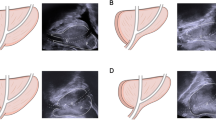Summary
To evaluate influence of age on symptomatology and objective parameters in benign prostatic hypertrophy, preoperative findings in 199 unselected patients during one year were analysed. Symptoms of bladder instability increased with age, as did incidence of uninhibited detrusor contractions and bladder trabeculation, whereas maximum urine flow and obstructive complaints decreased, although prostatic size was the same. In the oldest age groups only was increasing prostatic size associated with increasing bladder trabeculation. Age related changes in neurological control and in the structure of the bladder may be involved, and the present results suggest age to be an important factor in the interpretation of symptoms and objective findings in prostatic hypertrophy.
Similar content being viewed by others
References
Abrams PH, Feneley RCL (1978) The significance of symptoms associated with bladder outflow obstruction. Urol Int 33:171–174
Andersen JT, Nordling J, Walter S (1979) Prostatism I. The correlation between symptoms, cystometric and urodynamic findings. Scand J Urol Nephrol 13:229–236
Andersen JT, Mordling J (1980) Prostatism II. The correlation between cysto-urethroscopic, cystometric and urodynamic findings. Scand J Urol Nephrol 14:23–27
Andersen JT (1982) Prostatism: Clinical, radiological and urodynamic aspects. Neurol Urodyn 1:241–293
Campbell MF, Harrison JH (1970) Urology. Saunders, Philadelphia London Toronto, p 255
Castro JE, Griffiths HJL, Shackman R (1969) Significance of symptoms and signs in prostatic hypertrophy. Br Med J 2: 598–601
Dørflinger T, Nørgård JP, Simonsen O, Møller-Madsen B, Lundhus E, Olesen S, Jørgensen HS (1986) Hypertrophia prostatae — Et amtsmateriale. Ugeskr Læger 148:2149–2152
Freyer PJ (1900) A new method of performing prostatectomy. Lancet I:774–776
Frimodt-Møller PC, Jensen KME, Iversen P, Madsen PO, Bruskewitz RC (1984) Analysis of presenting symptoms in prostatism. J Urol 132:272–276
Lundhus E, Dørflinger T, Nørgård JP, Møller-Madsen B, Simonsen O, Olesen S, Jørgensen HS (1986) Hypertrophia prostatae — Betydningen af resectionens størrelse for ophævelsen af infravesical afløbshindring. Ugeskr Læger 148:2152–2154
Nielsen KK, Kristensen ES, Pedersen OS, Jensen HJ, Krarup T, Jensen KME (1986) Prostatectomy. Ugeskr Læger 148: 70–74
Susset JG (1983) Effects of aging and prostatic obstruction on detrusor morphology and function. In: Hinman F (ed) Benign prostatic hypertrophy. Springer, New York, pp 653–665
Turner-Warwick R (1979) A urodynamic review of bladder outlet obstruction in male and its clinical implications. Urol Clin North Am 6:171–192
Author information
Authors and Affiliations
Rights and permissions
About this article
Cite this article
Simonsen, O., Møller-Madsen, B., Dørflinger, T. et al. The significance of age on symptoms and urodynamic- and cystoscopic findings in benign prostatic hypertrophy. Urol. Res. 15, 355–358 (1987). https://doi.org/10.1007/BF00265667
Accepted:
Issue Date:
DOI: https://doi.org/10.1007/BF00265667




